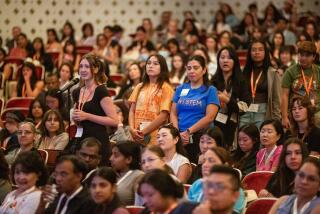Monster intellects
- Share via
THE wild-eyed mad scientist has been a staple of popular imagination since the early 19th century, when Mary Shelley gave us Dr. Frankenstein. Like the figure of the absent-minded professor, her tortured experimenter is not wholly fiction; modern psychology recognizes that asocial abnormalities (Asperger’s syndrome, for example) coexist easily with theoretical insights. But Shelley’s novel also spoke to her audience’s unease with the steam engines and factories transforming their landscape. Science, that bastion of abstract formulas and soulless equations, seemed to be remaking the world in its own deterministic image. Two centuries later, the polarities have shifted. Artists are happily wired to digital devices, while science has borrowed the language of mystics to talk of indeterminacy. Yet as Janna Levin’s novel, “A Madman Dreams of Turing Machines,” suggests, the outbreaks of irrationality suffered by adepts of pure reason still resonate, no matter how our view of science and madness has changed.
Levin’s book focuses on two eccentric geniuses whose work revolutionized 20th century thought: the Viennese logician Kurt Godel and the British mathematician and artificial-intelligence pioneer Alan Turing. Though contemporaries, the men never met. Levin, however, sets their lives in poignant counterpoint -- with each other and with the turmoil engulfing Europe before and after World War II. Moving between continents and decades, she shows us lives marked by ecstatic insight and wounding rejection. Levin, an astrophysicist, is determined to make us feel what it’s like to do science -- both the seemingly magical way ideas mushroom out of odd bits of observation and the corrosive fear that those ideas will remain disregarded, underfunded, stillborn.
Godel, painfully thin, eyes huge behind dark-framed glasses, looked the part of a madman. Born in 1906 to a family of wealthy textile manufacturers, he was fragile, a mama’s boy who dressed in layers of clothing -- multiple shirts, vests and trousers -- and feared that his food or the air was poisoned. By age 30, he’d been hospitalized twice for mental instability.
Yet at 21 his ability to see to the core of a logical problem and organize it symbolically was formidable enough to earn him an invitation to join the Wittgenstein-influenced thinkers who were reinventing philosophy one Thursday evening at a time in a smoky coffeehouse. On these men and women of the Vienna Circle, who held that mathematics by definition contains no unsolvable problems, Godel in 1931 dropped his bomb, his Incompleteness Theorems: There are statements, composed of words but translatable into numerical symbols, that make impossible claims about themselves. Such statements, for instance, as “This statement is unprovable” cannot be nailed down as either true or false by the rules of mathematical proof. But that inability to be nailed down is precisely what the statement advertises. It is therefore true, though that is recognized only by ignoring the rules. Godel’s construct, with its implications about the limits of human thought, met with more consternation than applause.
Meanwhile, another set of rules was becoming increasingly difficult to ignore. In a moving bit of storytelling, Levin shows Godel in 1938 insisting to the already dwindling Circle that Hitler’s authorities have no legal basis for firing him from his teaching position, since he is not in fact Jewish. “Kurt, that is hardly the point,” a colleague snaps. Wittgenstein has fled to England. Moritz Schlick, the Circle’s leader, has been gunned down outside his classroom by a student turned Nazi.
For Turing, the war offers his clearest sense of belonging. At boarding school, his combination of slovenly dress, graceless manner and unabashed homosexuality made his life hellish. (Classmates at one point buried him under the floorboards.) At Bletchley Park, Britain’s code-breaking center, he is just one among many eccentrics, all feverishly computing and competing. The goal is to crack the German machine-encrypted code Enigma, a stroke crucial to winning the war.
The dramatic possibilities of geek-turned-war-hero have been explored before -- in the play “Breaking the Code,” based on Andrew Hodges’ biography of Turing, and in Michael Apted’s film “Enigma,” based on Robert Harris’ novel -- but Levin shows us both the awkward outer man and the inward flare of intellect. During a blackout, Turing buries some bars of silver in the woods: “As he digs his hands in the earth shoveling away clumps of dirt he comes upon the root of a tree. A path through space. One possible path through earth. Then an idea fills him.... There is only one key to the encoded German transmission.... They shouldn’t be trying to find the one right code; they should be trying to shovel away all the wrong ones.” Like Godel’s theorems, Turing’s breakthrough involves a perceptual shift, inside to outside, figure to ground.
Levin’s first book, “How the Universe Got Its Spots,” showed her able to explain abstruse thought in vivid layman’s terms. An account, both technical and intimate, of her daily life as a cosmologist, it can also be read as an outcry against the stereotyping of scientists as defective humans. “Some of the great mathematicians killed themselves,” its first sentence announces. “The lore is that their theories drove them mad....” Needless to say, she’s not offering lore as proof.
Turing and Godel both committed suicide. For Levin, neither’s death is a simple equation; rather, like that tree root, each results from an accretion of inner impulses pressing against soil that is sometimes resistant. If there’s a commonality, it may be that genius is suspect in societies that prize conformity. Despite their contributions, both men found themselves marooned at the edge of the bell-shaped curve.
Godel’s final expression of mind over matter was to starve himself to death in leafy Princeton (where, in a nod to the mores of his new homeland, he kept a plastic flamingo on his lawn). Turing’s inability to deny his homosexuality led him to make a disastrous confession to policemen who he thought were investigating a burglary at his house. In 1952, private consensual relations between adult men were still a crime in Britain. He was convicted and subjected to estrogen treatments that changed his body irrevocably. He killed himself by eating a poisoned apple two years later.
One awkwardness in the novel is its narrator, whose voice occasionally intrudes to remark on the logical paradox of a novel rooted in biography and “invented” incidents that are nonetheless true. As a scientist, Levin may be comfortable with elaborate apparatus, but her fiction doesn’t need it. The play on the idea of an observer outside the system is a neat bit of flash, but she’s already made us see what she wants us to see: Three dimensions emerge from the flat page. Her characters and their century come brilliantly, irritably alive.
More to Read
Sign up for our Book Club newsletter
Get the latest news, events and more from the Los Angeles Times Book Club, and help us get L.A. reading and talking.
You may occasionally receive promotional content from the Los Angeles Times.







